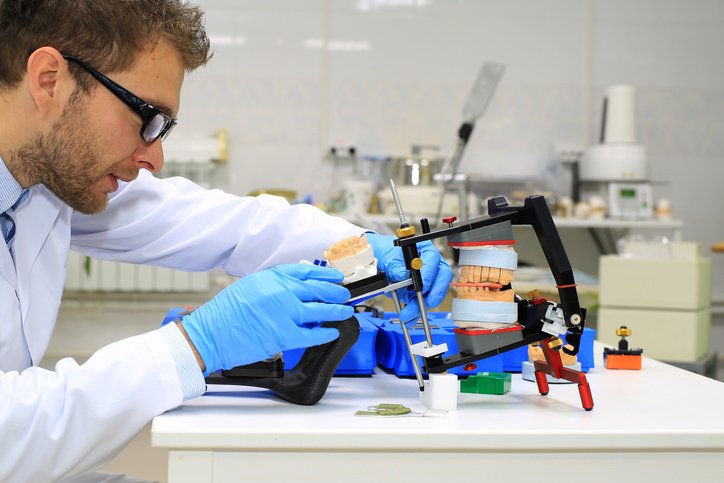<p>A dental lab helps in creating high-quality dental restorations. Dentists can outsource complex restorative cases to laboratories with the expertise, equipment, and materials needed to deliver quality craftsmanship. Here is how partnering with a lab can help manage complex restorative cases:</p>



<h2 class="wp-block-heading"><strong>Zirconia Crowns</strong></h2>



<p>Teeth undergo stresses daily from chewing, grinding, and other functions. Dentists may desire zirconia crowns for posterior teeth restorations. Zirconia’s strength makes it ideal for crowns, while its semi-translucency can mimic natural enamel’s appearance. Labs manufacture zirconia crowns using computer-aided design (CAD) and milling technology to match the size and anatomy of patients’ gums and tissues for proper margins. Outsourcing zirconia crowns allows dentists to focus on the clinical aspects of complex restorative cases.</p>



<h2 class="wp-block-heading"><strong>Full Dentures</strong></h2>



<p>Creating comfortable, practical, complete dentures requires capabilities beyond standard dental practice. Full dentures replace lost crowns and support collapsed tissues, restoring oral function and facial structure. Labs have the materials to craft complete upper and lower dentures, including wax, high-impact acrylic, and porcelain teeth. Dental technicians combine these materials to produce durable dentures. Labs have skilled artisans who shape teeth to reestablish proper bite alignment and anatomy based on dentists’ models and design specifications. Outsourcing denture cases allows dentists to receive quality work from reliable lab professionals.</p>



<h2 class="wp-block-heading"><strong>Partial Dentures</strong></h2>



<p>Labs manufacture removable partial dentures to replace missing teeth when patients have some existing healthy teeth. Removable partials anchor to these remaining teeth, filling in gaps where teeth are missing. Labs also produce hybrids with replacement crowns fused to a metal framework for added strength. They fabricate complete upper and lower partials from metal alloys. Laboratories add acrylic gums to supporting structures before setting replacement teeth on partial dentures. Outsourcing removable partials to laboratories can contribute to restorative treatment planning.</p>



<h2 class="wp-block-heading"><strong>Implant Abutments</strong></h2>



<p>Dental laboratories partner with dentists and other oral health professionals to produce implant-supported restorations. Labs fabricate partial and complete screw-retained overdentures, which attach to patients’ implants for stability. Total coverage reduces sore spots compared to traditional dentures. With in-house CAD/CAM systems, labs can manufacture titanium and zirconia implant abutments for crowns based on models of patients’ implant placements. Treatment planning analyzes the bone volume and quality for the abutment and surgical guide recommendations.</p>



<h2 class="wp-block-heading"><strong>Mouthguards</strong></h2>



<p>Night guards protect restorations by buffering occlusal forces from bruxism. Mouthguards also absorb forces in sports that could fracture prosthodontic work. With capabilities to manufacture customized night guards and mouthguards specific to patients’ needs, labs provide the protection needed for restorations to last. A<a href="https://mabeldental.com"> <strong>dental lab</strong></a> can fabricate night guards from durable thermoplastics or hard acrylics that fit precise dental anatomy. Labs may add a liner for comfort or occlusal contact acrylic for bruxers. ;</p>



<h2 class="wp-block-heading"><strong>Orthodontic Aligners</strong></h2>



<p>Crowded, gapped, or misaligned teeth compromise oral function and aesthetics, impacting long-term oral wellness. Laboratories offer orthodontic aligners to shift teeth into alignment before restorative treatment begins. Labs manufacture aligner trays that patients wear according to their treatment plan. They analyze models and craft aligners that will fit with crowns, bridges, veneers, or implants. A pre-restorative ortho program helps dentists achieve therapeutic outcomes. Aligner technology gives dentists alternatives to traditional braces for certain patients.</p>



<h2 class="wp-block-heading"><strong>Visual Diagnostic Aids</strong></h2>



<p>Beyond fabricating restorations and appliances, labs can provide diagnostic visual aids. Lab-generated digital diagnostic wax-ups show planned aesthetics to help dentists and patients visualize the final transformations before treatment begins. Guided imaging files specify ideal implant placement to restore retention and load distribution in areas with adequate bone structure. Sectional models showcase how orthodontic movement can align teeth with pre-restorative treatment. These visual aids may enable dental surgeries to progress with fewer appointments and reduced chair time.</p>



<h2 class="wp-block-heading"><strong>Contact a Dental Lab Today</strong></h2>



<p>Dental technology, such as digital imaging and 3D printing, contributes to streamlined dental processes. Partner with a dental lab that combines expert craftsmanship and modern technology. Start your search for a reputable lab today.</p>

The Role of Dental Labs in Complex Restorative Cases

